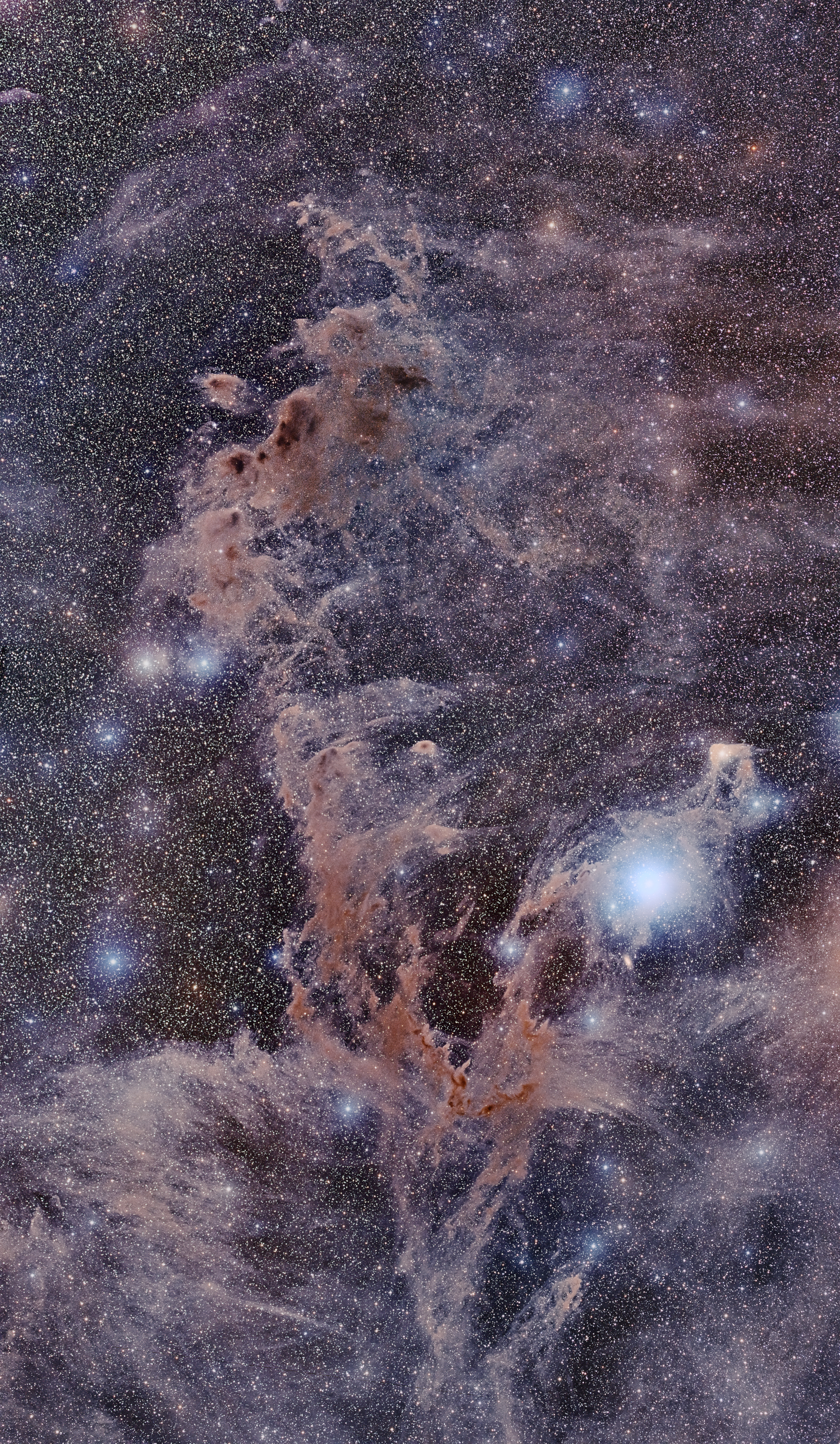Chamäleon-KomplexChamaeleon complex
 Fahre mit der Maus über das Bild um es zu vergrössern
Move the mouse over the image to enlarge it
Fahre mit der Maus über das Bild um es zu vergrössern
Move the mouse over the image to enlarge it
 Klicke das Bild für eine grössere Ansicht an
Click the image for a larger view
Klicke das Bild für eine grössere Ansicht an
Click the image for a larger view
Der Chamaeleon-Komplex ist eine große sternbildende Region (SFR) an der Oberfläche der lokalen Blase, die die Dunkelwolken Chamaeleon I, Chamaeleon II und Chamaeleon III umfasst. Sie nimmt fast das gesamte Sternbild Chamaeleon ein und überschneidet sich mit Apus, Musca, Carina und Octans. Die mittlere Dichte der Röntgenquellen beträgt etwa eine Quelle pro Quadratgrad.
Details über die Dunkelwolke Chamaeleon I
Die Chamaeleon I (Cha I) Wolke ist eine der nächstgelegenen aktiven Sternentstehungsregionen in ~160 pc. Sie ist relativ isoliert von anderen Sternentstehungswolken, so dass es unwahrscheinlich ist, dass ältere Vor-Hauptreihen-Sterne (PMS) in das Feld eingedrungen sind. Die gesamte stellare Population beträgt 200-300. Die Cha-I-Wolke wird weiter unterteilt in die Nordwolke oder Region und die Südwolke oder Hauptwolke.
HD 97300 sendet Röntgenstrahlen aus, beleuchtet den Reflexionsnebel IC 2631 und ist einer der massereichsten Vertreter der Cha-I-Wolke, Spektraltyp B9V, ein Herbig-Ae/Be-Stern ohne Emissionslinien.
Reflexionsnebel IC 2631
Cha Halpha 1 ist ein Objekt des Spektraltyps M8 in der Chamaeleon I-Dunkelwolke, das 1998 als Röntgenquelle bestimmt wurde und als solcher der erste gefundene röntgenstrahlende Braune Zwerg ist.
Details zur Dunkelwolke Chamaeleon II
Chamaeleon II enthält die Uhuru-Quelle 4U 1302-77. Sie befindet sich in der Nähe von RXJ 1303.1-7706 bei RA 13h 03m 04.70s Dec -77° 06' 55.0", einem neuen K7-M0 WTT. Die Dunkelwolke von Chamaeleon II enthält etwa 40 Röntgenquellen. Die Beobachtung in Chamaeleon II wurde vom 10. bis 17. September 1993 durchgeführt. Die Quelle RXJ 1301.9-7706, ein neuer WTTS-Kandidat des Spektraltyps K1, befindet sich am nächsten zu 4U 1302-77.
Details über die Dunkelwolke Chamaeleon III
In Chamaeleon III scheint es derzeit keine Sternentstehungsaktivität zu geben. Es gibt zwei besonders auffällige Nebel, die mit diesem Gebiet verbunden sind. Der kleinere ist allgemein als Daumenabdrucknebel und der größere als Talonnebel bekannt.
Quelle der Beschreibung: WikipediaThe Chamaeleon complex is a large star forming region (SFR) at the surface of the Local Bubble that includes the Chamaeleon I, Chamaeleon II, and Chamaeleon III dark clouds. It occupies nearly all of the constellation Chamaeleon and overlaps into Apus, Musca, Carina and Octans. The mean density of X-ray sources is about one source per square degree.
Details about the Chamaeleon I dark cloud
The Chamaeleon I (Cha I) cloud is one of the nearest active star formation regions at ~160 pc. It is relatively isolated from other star-forming clouds, so it is unlikely that older pre-main sequence (PMS) stars have drifted into the field. The total stellar population is 200–300. The Cha I cloud is further divided into the North cloud or region and South cloud or main cloud.
HD 97300 emits X-rays, illuminates the reflection nebula IC 2631 and is one of the highest mass members of the Cha I cloud, spectral type B9V, a Herbig Ae/Be star without emission lines.
Reflection nebula IC 2631
Cha Halpha 1 is an object of spectral type M8 in the Chamaeleon I dark cloud that was determined in 1998 to be an X-ray source and as such is the first X-ray emitting brown dwarf found.
Details about the Chamaeleon II dark cloud
Chamaeleon II contains the Uhuru source 4U 1302–77. It is close to RXJ 1303.1-7706 at RA 13h 03m 04.70s Dec -77° 06' 55.0", a K7-M0 new WTT. The Chamaeleon II dark cloud contains some 40 X-ray sources. Observation in Chamaeleon II was carried out from September 10 to 17, 1993. Source RXJ 1301.9-7706, a new WTTS candidate of spectral type K1, is closest to 4U 1302–77.
Details about the Chamaeleon III dark cloud
Chamaeleon III appears to be devoid of current star formation activity. There are two particularly prominent nebulae associated with this area. The smaller is commonly known as the Thumbprint Nebula and the larger The Talon Nebula.
Source of description: WikipediaAufnahmedetails Acquisition details
Frames:
Aufnahmedauer insgesamt: Total integration time: 12h 00m
Verwendete Ausrüstung Equipment used